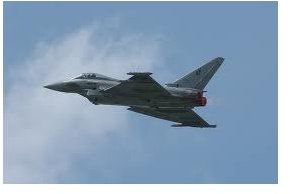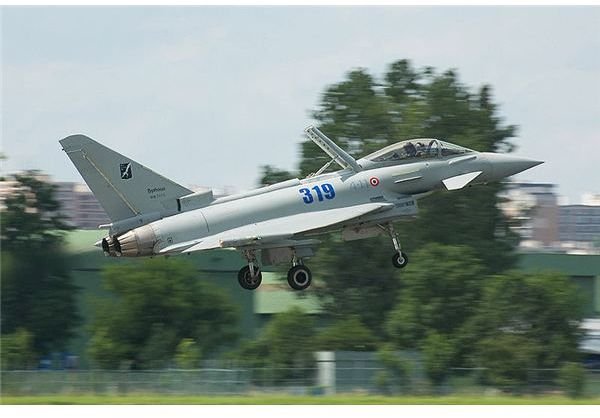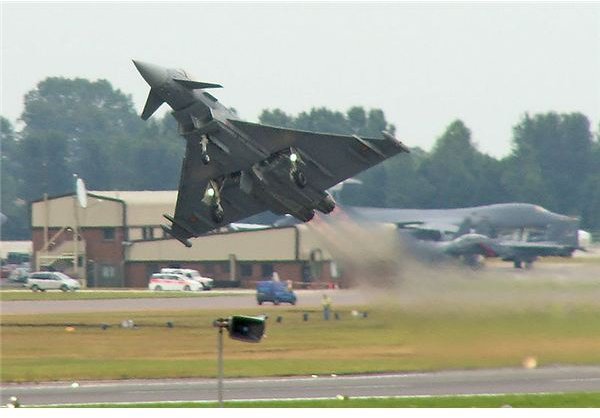Typhoon Eurofighter Technology is State of the Art
The Typhoon: Eurofighter Technology
In the 1980s, several European NATO allies convened to discuss the future of pan-European cooperation in the sphere of combat aviation. The Tornado strike aircraft had been largely a success, and Britain, Italy, Spain, Germany, and France all sought a new fighter aircraft that could replace many of the aging airframes currently in service and compete with potential adversaries such as the Russian Flanker.
Though France dropped its participation in the project and chose to build Dassault Rafale fighter jets that met its particular requirements, the Eurofighter project carried on through the 1980s and 1990s even after the end of the Cold War. The result: The Typhoon! Eurofighter technology is widely considered top notch, and the aircraft is in service with 5 nations - Germany, Britain, Spain, Italy, and Austria, and has been bought by Saudi Arabia. In addition, the Indian M-MRCA competition includes the Typhoon, Eurofighters are reportedly at or near to the top of the wishlist for the Indian Air Force.
In 2011 the Indian government publicly shortlisted the Typhoon alongside the Rafale as the two final contenders for the M-MRCA contract. Though this had been rumored to be in the world since 2010, the official confirmation sealed all doubt and showed the world that the Eurofighter was viewed as superior by the Indian Air Force to the American F-18 and F-16, the Russian MiG-35, and the Swedish Gripen. In effect, the Indian government’s choice indicates that the Eurofighter and Rafale are technically superior to all other generation 4.5 combat aircraft, at least as far as Indian needs are concerned.
Structure of the Typhoon
The Typhoon’s development was long and difficult, a natural side effect of a project that was perpetually coordinated between four nations, each of which assembles its own aircraft but produces specific parts used by all Typhoons. Eurofighter requirements eventually evolved to match the aircraft finally produced: a delta wing fighter with control canards close to the cockpit, two engines each capable of supercruise and equipped with an afterburner, and a state of the art cockpit fully equipped with digital displays that lacks any analog switches or other old style aviation equipment.
The cockpit is additionally equipped with a technology quite new to modern aircraft - voice control, designed to decrease needed manual pilot input and reduce the overall workload the pilot must manage. In addition, modern g-suits meant to protect the pilot from the rigors of high energy maneuvers have been integrated into the design, which allow pilots to maintain consciousness even during extremely tight turns and other physically stressful maneuvers.
The Indian M-MRCA competition indicates the Typhoon’s versatility in a variety of environments. India is unique in that its frontiers stretch from the Indian ocean all the way into the high Himalayas - the worlds tallest mountains. Aircraft in Indian service must be able to handle operations at very high elevations as well as at sea level. And the Eurofighter has been able to do so - far better than American aircraft that reportedly had difficulty starting their engines at high altitudes.
Teeth of the Eurofighter
The Eurofighter was designed from the outset to mount a wide variety of ordnance and electronic technology sufficient to defeat likely threats faced in the twenty-first century. Primarily meant to be an aircraft focused on air to air combat, taking on other, similar aircraft, the emerging need for ground support missions has altered the mission profile of the Typhoon. Eurofighter aircraft are being upgraded to carry a more full array of air to ground ordnance than originally anticipated, and new aircraft off the production lines come equipped to use a wide range of missiles and bombs.
The Eurofighter is capable of fielding Sidewinder, ASRAAM, and AMRAAM air to air missiles, and when the new, long range METEOR missile becomes available it will be integrated into the Typhoon.
Eurofighter air to ground ordnance capabilities include the Maverick, HARM, Taurus, and Joint Direct Attack Munition weapons systems and it can also mount laser guided bombs.

Electronics are where the Eurofighter Typhoon truly shines. Aside from the glitz of the all digital cockpit, the Typhoon is meant to have both active and passive detection and countermeasure systems. Its radar is state of the art, and by 2015 an upgrade will be installed called the active electronically scanned array radar which will enhance effective missile range and provide a technological leap forward over competitors to the Typhoon. Eurofighters also come equipped with a passive infra-red detection system, long common on Soviet-era and Russian fighters, which allows the aircraft to detect potential threats without giving away its position by transmitting its own radar signals.
Finally, though the Europeans do not have a true stealth fighter in the Typhoon, Eurofighter aircraft do have a significantly reduced radar cross section that makes it harder to detect than most similarly sized aircraft.
Eurofighter Dogfighting Potential
The Eurofighter Typhoon was designed from the landing gear on up as a highly capable dogfighter. While it was always intended that the aircraft would be able to use long range air to air missiles such as the AMRAAM and eventually METEOR, European defense analysts knew that Eurofighter dogfighting capabilities had to be top notch, because every time in aviation history that experts thought that close range combat was a thing of the past, circumstances contrived to prove them wrong.

The Eurofighter boasts a high thrust to weight ratio and low wing loading. This makes for a quick, agile aircraft capable of making tight turns. It boasts a higher service ceiling and better climb rate than most of its contemporaries as well, which allows a Eurofighter dogfighting with an opponent with equal or superior handling in the horizontal plane to choose its maneuvers to match the weaknesses of its opponent.
Another important, if potentially overlooked, component of Eurofighter dogfighting capabilities is its low radar cross section and its possession of passive detection sensors, namely its infrared sensor. This gives the Typhoon the ability to sneak up on an opponent, relying on its stealth relative to contemporary fighters as well as its speed and ability to detect heat signatures without broadcasting electronic emissions of its own.
Typhoon Close Engagement History
Although it has been in service only a short time, several reported incidents where Eurofighter dogfighting capabilities have been unexpectedly put on display speak favorably to the fighter’s power. In addition, a United States general has flown both the Eurofighter Typhoon and F-22 Raptor, and so is in a unique situation where he can compare the two aircraft.
General John Jumper did not outright claim superiority for either the Raptor or Typhoon. Eurofighter aircraft and the F-22 design, he felt, could not be adequately compared because they were meant to do different things. The Eurofighter should be praised, in his opinion, for being high tech and extremely maneuverable. The F-22 was meant as a stealth penetration fighter, able to penetrate enemy airspace and disrupt it so fully that follow on fighters like the F-35 could finish the job. The Eurofighter on the other hand was always meant as an air defense and air superiority fighter capable of winning close battles with similar opponents. The two missions mean that the two fighters are difficult to compare, and could potentially outperform one another depending on circumstance.

Eurofighter dogfighting capability has been demonstrated several times. First, it has been reported in some media outlets that two US F-15E Strike Eagles on a routine flight in Britain “jumped” (snuck up on) a Typhoon on a training mission and initiated a dogfight. To everyone’s surprise, the Eurofighter broke away and maneuvered into a position where in a real combat it would have killed both F-15s.
A more widely publicized event took place when Indian SU-30 Flanker aircraft participated in exercises with British Eurofighters. While the Flanker variant was said to be more maneuverable in some respects, the Eurofighters still performed well and impressed their Indian counterparts.
Finally, a German aviation magazine reported that in several training dogfights between French Rafales and German Eurofighters, the Eurofighters proved superior in large part due to their more potent engines.
Eurofighter Structural Stats and Deployment
- 36 foot wingspan, 17 feet high, 52 feet long
- 2 Engines, Max speed of Mach 2.0 at altitude, Mach 1.2 at sea level
- Acceleration from 200 knots to Mach 1 at sea level in 30 seconds
- Ceiling over 60,000 feet, climb rate around 60,000 feet per minute
- 12 tons empty, 17.5 tons loaded, max takeoff weight of around 26 tons
- 1,800 mile range, mission dependent combat radius 300-850 miles
- 64 pounds per feet squared wing loading, thrust to weight ratio 1.15
- Internal gun armament: 1 27mm Mauser cannon with 150 rounds
- 8 under wing and 5 under fuselage hardpoints - 8 ton max load
In March 2011 the Eurofighter was deployed over Libya in an attempt to stop the Libyan regime from crushing opposition forces in Benghazi and the rest of eastern Libya. It has performed a variety of air patrol and ground attack missions and has been an integral part of the NATO mission there. Due the proximity of NATO airbases to Libya the Eurofighter has flown from Spanish and Italian airfields and possibly served as part of British strike packages that launched all the way from the British Isles to attack Libya.
References
Eurofighter Typhoon homepage, https://www.eurofighter.com/eurofighter-typhoon/technicaldata.html
BAE Systems Typhoon (Eurofighter), https://www.baesystems.com/ProductsServices/autoGen_106920114440.html
Domain B article on Eurofighter-SU-30 matchup, https://www.domain-b.com/aero/july/2007/20070720_indra_dhanush.htm
